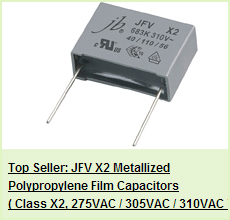2011-10-10 1:4:11
views
Keywords: Polarised, DC power supply circuit, large capacitance.
Electrolytic Capacitors are generally used when very large capacitance values are required. Here instead of using a very thin metallic film layer for one of the electrodes, a semi-liquid electrolyte solution in the form of a jelly or paste is used which serves as the second electrode (usually the cathode). The dielectric is a very thin layer of oxide which is grown electro-chemically in production with the thickness of the film being less than ten microns. This insulating layer is so thin that it is possible to make capacitors with a large value of capacitance for a small physical size as the distance between the plates, D is very small.
The majority of electrolytic types of capacitors are Polarised, that is the DC voltage applied to the capacitor terminals must be of the correct polarity, i.e. positive to the positive terminal and negative to the negative terminal as an incorrect polarisation will break down the insulating oxide layer and permanent damage may result. All polarised electrolytic capacitors have their polarity clearly marked with a negative sign to indicate the negative terminal and this polarity must be followed.
Electrolytic Capacitors are generally used in DC power supply circuits due to their large capacitances and small size to help reduce the ripple voltage or for coupling and decoupling applications. One main disadvantage of electrolytic capacitors is their relatively low voltage rating and due to the polarisation of electrolytic capacitors, it follows then that they must not be used on AC supplies. Electrolytic's generally come in two basic forms: Aluminum Electrolytic Capacitors and Tantalum Electrolytic Capacitors.
Structure

2011-10-7 23:40:15
views
Sie sind auf der Suche nach einem exzelentem und zuverlässigen ondensatorhersteller in China?
Dann können wir von jb Capacitors helfen!
Mein Name ist Chaney und ich betreue unsere Kunden in Deutschland.
Unser Lieferprogramm:
JFA-Mylar Polyester Film Kondensator (CL-11)
JFB-Metall Polyester Film Kondensator (CL-21)
JFE-Mini Metall Polyester Film Kondensator (CL-21X)
JFD-Box Type Metall Polyester Film Kondensator (CL-23)
JFG-Axial Metall Polyester & Polypropylene Film Kondensator
JFL-Metall Polypropylen Film Kondensator (CBB-21)
JFV-X2 Metall Polypropylen Film Kondensator, with safety approvals
JFP-High Voltage Metall Polypropylen Film Kondensator (CBB81)
JCS-SMD Typ Aluminum Electrolyt Kondensator, 85C, 2000H
JCK-SMD Typ Aluminum Electrolyt Kondensator, 105C, 1000H
Wir garantieren:
Qualität, ISO9001 : 2000 Zertifizierung seit 1980 (!)
Erfahrung im Kondensatorbau seit über 30 Jahren
Pünktliche Lieferung innerhalb von 5 bis 7 Wochen
Beste Verpackung nach deutschen Qualitätsansprüchen
Beste Technologie aus Taiwan und Hongkong
Internationale Safety – Standards cUL, CSA, VDE, GS etc
Unschlagbares Preis/ Leistungsverhältnis, Kein Zwischenhandel
Ich freue mich auf Ihre Anfrage - Sie erhalten umgehend unser Angebot.
Für weitere Informationen stehe ich Ihnen jederzeit gerne zur Verfügung.
Sie erreichen mich persönlich zu Ihren gewohnten deutschen Geschäftszeiten.
Mit herzlichen Grüßen nach Deutschland
Chaney ( info@jbcapacitors.com)
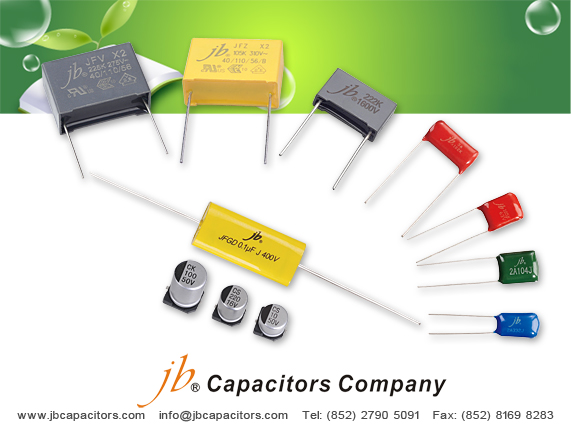
2011-9-30 23:20:47
views
Keywords: Polarised, DC power supply circuit, large capacitance.
Electrolytic Capacitors are generally used when very large capacitance values are required. Here instead of using a very thin metallic film layer for one of the electrodes, a semi-liquid electrolyte solution in the form of a jelly or paste is used which serves as the second electrode (usually the cathode). The dielectric is a very thin layer of oxide which is grown electro-chemically in production with the thickness of the film being less than ten microns. This insulating layer is so thin that it is possible to make capacitors with a large value of capacitance for a small physical size as the distance between the plates, D is very small.
The majority of electrolytic types of capacitors are Polarised, that is the DC voltage applied to the capacitor terminals must be of the correct polarity, i.e. positive to the positive terminal and negative to the negative terminal as an incorrect polarisation will break down the insulating oxide layer and permanent damage may result. All polarised electrolytic capacitors have their polarity clearly marked with a negative sign to indicate the negative terminal and this polarity must be followed.
Electrolytic Capacitors are generally used in DC power supply circuits due to their large capacitances and small size to help reduce the ripple voltage or for coupling and decoupling applications. One main disadvantage of electrolytic capacitors is their relatively low voltage rating and due to the polarisation of electrolytic capacitors, it follows then that they must not be used on AC supplies. Electrolytic's generally come in two basic forms: Aluminum Electrolytic Capacitors and Tantalum Electrolytic Capacitors.
Structure
2011-8-8 15:16:32
views
A photoflash capacitor is an electrolytic capacitor used in flash cameras, professional flashes, and also in solid-state laser power supplies. Their usual purpose is to briefly power a high-voltage flash tube, used to illuminate a photographic subject or optically pump a laser rod. As flash tubes require very high current for a very short time to operate, photoflash capacitors are designed to supply high discharge current pulses without excessive internal heating.
Photoflash Aluminum Electrolytic Capacitors are very special capacitors and need very high quality and professional technology. I have friends told me that jb Capacitors Company produce very good quality photoflash electrolytic capacitors. JSU Series--Photo-Flash-Lug-Aluminum-Electrolytic-Capacitors. Here is the datasheet link:http://www.jbcapacitors.com/Aluminum-Electrolytic-Capacitors/JSU-Photo-Flash-Lug-Aluminum-Electrolytic-Capacitor.html
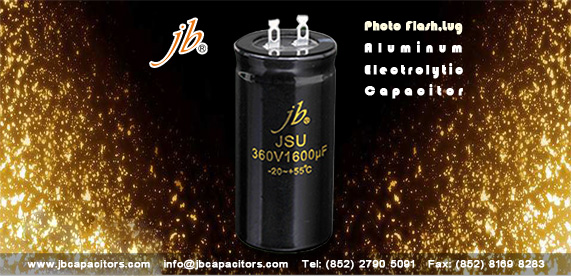
2011-8-5 15:3:2
views
jb capacitors company is very strong on Aluminum electrolytic capacitors, including snap-in, screw type and lug type.
Snap-in Aluminum Electrolytic Capacitors is widely used on power supply. If the end product is industrial motor, some customer may requires to add a mica sheet of plastic layer or other non-flammable material between the Aluminum electrolytic body and PCB. As we know, the motor has vibrations, and it keeps running 24 hours, so that the capacitor will be very hot. The piece of plastic layer is used as insulation to prevent the capacitor from shorting itself.
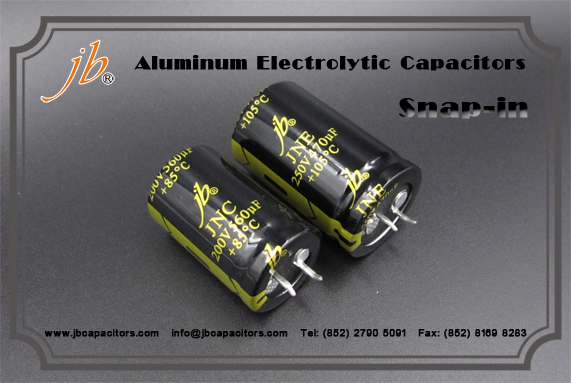
2011-8-1 15:49:43
views
jb capacitors company not only produce MKT MKP Film capacitors, also produce high quality Screw
terminals Aluminum Electrolytic capacitors, some people called Large can aluminum electrolytic capacitors, I.E. Snap-in, Screw, Lug type. Long load life, high ripple current...
Recently jb strongly recommend screw type aluminum electrolytic capacitors, with very high quality, widely use in power supply, UPS, Welding Machines, filter etc...
See below our strong series:
JMJ--Screw terminal aluminum electrolytic capacitors, 2000hours at 85C'---cross: Epcos B41456,B41458/ B43456,B43458/ B43564, B43584/ B43455, B43457 CDE: CGS series
JML--Screw terminal aluminum electrolytic capacitors, 2000hours at 105C'--Cross:
Epcos B43740,B43760/B41560,B41580/ B43450,B43770(high ripple current)
JMN--Screw terminal aluminum electrolytic capacitors, 5000hours at 85C'
JMQ--Screw terminal aluminum electrolytic capacitors, 5000hours at 105C'
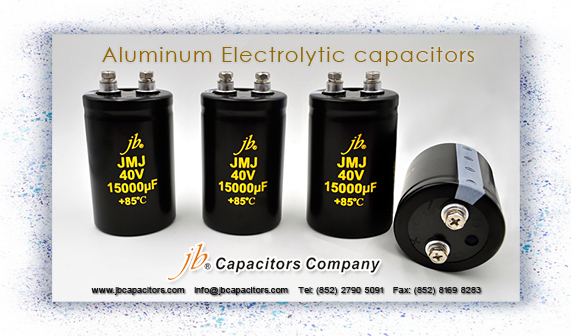
2011-7-29 15:36:24
views
jb capacitors company is very strong on Aluminum electrolytic capacitors, including snap-in, screw type and lug type.
Snap-in Aluminum Electrolytic Capacitors is widely used on power supply. If the end product is industrial motor, some customer may requires to add a mica sheet of plastic layer or other non-flammable material between the Aluminum electrolytic body and PCB. As we know, the motor has vibrations, and it keeps running 24 hours, so that the capacitor will be very hot. The piece of plastic layer is used as insulation to prevent the capacitor from shorting itself.
2011-7-15 23:19:12
views
Tape and Reel is a process of packing surface mount devices (SMD's) by loading them into individual pockets comprising what is known as a pocket tape or carrier tape. The carrier tape is wound around a reel for convenient handling and transport. The reel is enclosed in a reel box before it is finally shipped to the customer.
A Tape-and-Reel holds hundreds-to-thousands of surface mount devices. This saves in labor and will further reduce manufacturing costs for automated circuit board assembly.
jb capacitors company manufactures and markets SMD Aluminum Electrolytic capacitors. They are both with tape-and-reel package.
JCS - 2000H at 85°C SMD Aluminum Electrolytic Capacitors
JCK- 1000H at 105°C SMD Aluminum Electrolytic Capacitors
2011-6-27 15:20:51
views
JMQ is one of our screw type aluminium electrolytic capaciotrs. it can be used in electrical source panel.
And one of the panel function is that it can control pulse current discharge in plasma generator device.
Pls. click the link for the specification.
http://www.jbcapacitors.com/pdf/JMQ-5000H-at-105-Screw-Aluminum-Electrolytic-Capacitor.pdf
2011-6-3 12:57:2
views
Aluminum is used for the electrodes by using a thin oxidization membrane. Large values of capacitance can be obtained in comparison with the size of the capacitor, because the dielectric used is very thin. The most important characteristic of electrolytic capacitors is that they have polarity. They have a positive and a negative electrode.[Polarised] This means that it is very important which way round they are connected. If the capacitor is subjected to voltage exceeding its working voltage, or if it is connected with incorrect polarity, it may burst. It is extremely dangerous, because it can quite literally explode. Make absolutely no mistakes.
Generally, in the circuit diagram, the positive side is indicated by a "+" (plus) symbol.
Electrolytic capacitors range in value from about 1µF to thousands of µF. mainly this type of capacitor is used as a ripple filter in a power supply circuit, or as a filter to bypass low frequency signals, etc. Because this type of capacitor is comparatively similar to the nature of a coil in construction, it isn't possible to use for high-frequency circuits. (It is said that the frequency characteristic is bad.)





